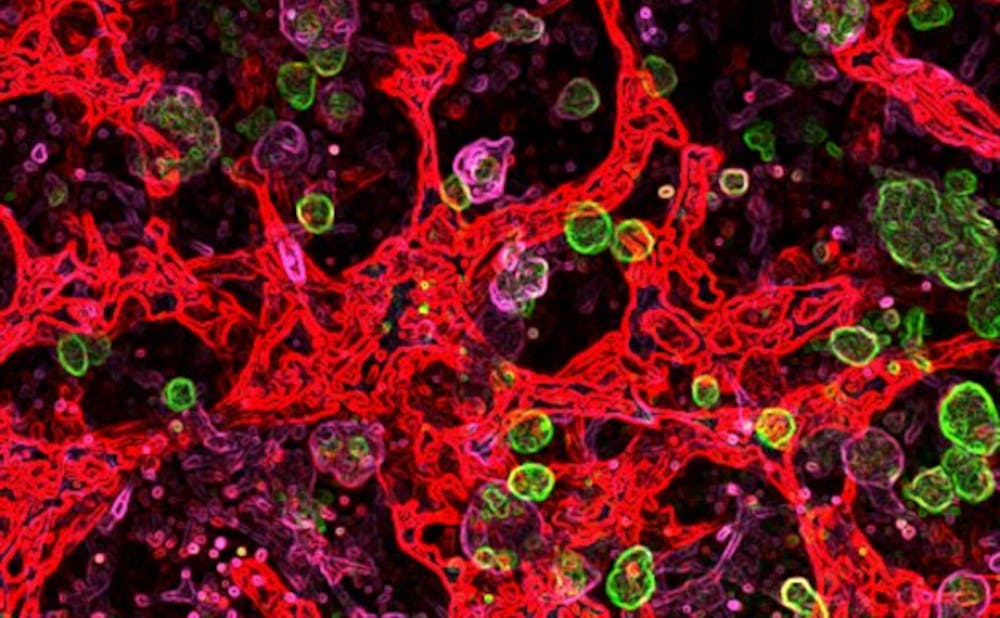Liver cells, water droplets and crabs. Wildflowers, ion beams and protein models. These have all been subjects of winning photos in the Envisioning the Invisible photo contest hosted by the Engineering Graduate Student Council.
The EGSC puts on an awards reception each year to announce the winners. This year, that reception will be held Jan. 19 from 5 to 6 p.m. in the Fitzpatrick Atrium. Trisha Dupnock, president of the EGSC and fourth-year PhD student, said the judges decide the winners of the top three places, while attendees of the event will vote on a People’s Choice award. Each of the awards comes with a cash prize: $500, $300 and $200, for first, second and third place respectively, and $100 for the People’s Choice.
In past years, people could vote online for the People’s Choice award, but Dupnock said this year there will be an in-house ballot at the event. EGSC members will pass out tickets for attendees to place into boxes under each submission. For those who cannot attend the event, Dupnock said there will be early voting available if they can stop by earlier in the day.
Jennifer West, associate dean for PhD education in the Pratt School of Engineering, has been involved with the contest for the past three years. West said they typically receive 40 to 50 submissions each year, and Dupnock said the photos will be displayed throughout the year in the Fitzpatrick Atrium, starting a few days before the awards reception.
“Ideally, visitors to the show will find images visually compelling and then learn about the exciting research behind the image,” West wrote in an email.
Dupnock said the event and the contest aim to “bridge the gap” between the sciences and the arts as well as to include the wider Duke community beyond the Pratt School.
“Anybody from the Duke community is able to submit a photo,” Dupnock said. “We’ve been trying to really branch outside of the Pratt department and get other schools like the medical school, the Trinity School, the Nicholas school involved, so a big push this year was to find the communications people for those schools and get the word out about the event.”
Another way the EGSC is branching out this year is by creating a partnership with the Pratt recruitment event, which Dupnock said is also happening Jan. 19. That event typically has a reception at the end of the day, so this year’s reception will occur concurrently with the reception for the photo contest.
The submission period for the contest started in the fall and ended Dec. 22. Dupnock said the contest looks for photos that either come from highly scientific research presented in an artistic way or from everyday life presented in an extraordinary way that “captures the scientific underlying” of the subject. The judges then consider both of these qualities.
Last year’s first place winner was Asli Unal, a fourth-year PhD student in biomedical engineering. Her winning photo of liver cells came from a construct she made in a lab by encapsulating three kinds of cells into a hydrogel. Unal said she heard about the contest from an EGSC announcement and wanted to show others what she was seeing in her work.
“Winning was of course awesome,” Unal wrote in an email. “I didn't expect it — there were so many beautiful images that were submitted. I was really happy that people liked my photo as much as I did.”
Unal’s submission represents the theme of the contest, Envisioning the Invisible, by capturing images on a very small scale. George Truskey, senior associate dean in the Pratt School of Engineering, said the contest originally started in 2010 as a memorial to a graduate student who was murdered, but it has since removed the student’s name from the contest title in order to shift the focus.
“By emphasizing the invisible, it’s trying to use photography and other imaging methods to explore the beauty that exists at all different levels, particularly the microscopic, and how some things that we view as scientific can actually also be viewed as beautiful art,” Truskey said.
Get The Chronicle straight to your inbox
Signup for our weekly newsletter. Cancel at any time.

